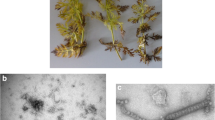Summary.
Recently obtained molecular and biological information has prompted the revision of the taxonomic structure of the family Closteroviridae. In particular, mealybug-transmitted species have been separated from the genus Closterovirus and accommodated in a new genus named Ampelovirus (from ampelos, Greek for grapevine). Thus, the family now comprises three genera. Their major properties are (i) Closterovirus: type species Beet yellows virus, genome monopartite, 15.5–19.3 kb in size, a 22–25 kDa major coat protein (CP), the gene encoding the divergent CP analogue (CPd) upstream of the CP cistron, transmission by aphids, a membership of 8 definitive and 4 tentative species; (ii) Ampelo-virus: type species Grapevine leafroll virus 3, genome monopartite 16.9–19.5 kb in size, a 35–37 kDa major CP, a CPd cistron generally located downstream of the CP gene, transmission by pseudococcid and coccid mealybugs, a membership of 6 definitive and 5 tentative species; (iii) Crinivirus: type species Lettuce infectious yellows virus, genome essentially bipartite 15.3–19 kb in size, a 28–33 kDa CP, a CPd cistron downstream of the CP gene, transmission by whiteflies (Bemisia, Trialeurodes), a membership of 7 definitive and 3 tentative species. There are five unassigned species in the family.
Article PDF
Similar content being viewed by others
Avoid common mistakes on your manuscript.
Author information
Authors and Affiliations
Rights and permissions
About this article
Cite this article
Martelli, G., Agranovsky, A., Bar-Joseph, M. et al. The family Closteroviridae revised. Arch Virol 147, 2039–2044 (2002). https://doi.org/10.1007/s007050200048
Issue Date:
DOI: https://doi.org/10.1007/s007050200048




